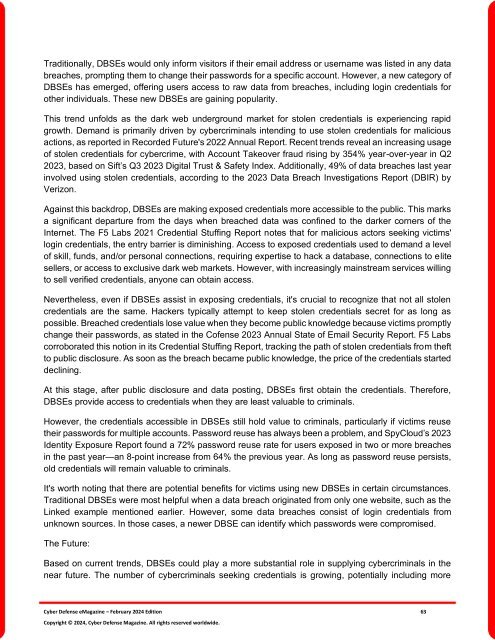The Cyber Defense eMagazine February Edition for 2024
Cyber Defense eMagazine February Edition for 2024 #CDM #CYBERDEFENSEMAG @CyberDefenseMag by @Miliefsky a world-renowned cyber security expert and the Publisher of Cyber Defense Magazine as part of the Cyber Defense Media Group as well as Yan Ross, Editor-in-Chief and many more writers, partners and supporters who make this an awesome publication! 155 page February Edition fully packed with some of our best content. Thank you all and to our readers! OSINT ROCKS! #CDM #CDMG #OSINT #CYBERSECURITY #INFOSEC #BEST #PRACTICES #TIPS #TECHNIQUES
Cyber Defense eMagazine February Edition for 2024 #CDM #CYBERDEFENSEMAG @CyberDefenseMag by @Miliefsky a world-renowned cyber security expert and the Publisher of Cyber Defense Magazine as part of the Cyber Defense Media Group as well as Yan Ross, Editor-in-Chief and many more writers, partners and supporters who make this an awesome publication! 155 page February Edition fully packed with some of our best content. Thank you all and to our readers! OSINT ROCKS! #CDM #CDMG #OSINT #CYBERSECURITY #INFOSEC #BEST #PRACTICES #TIPS #TECHNIQUES
Create successful ePaper yourself
Turn your PDF publications into a flip-book with our unique Google optimized e-Paper software.
Traditionally, DBSEs would only in<strong>for</strong>m visitors if their email address or username was listed in any data<br />
breaches, prompting them to change their passwords <strong>for</strong> a specific account. However, a new category of<br />
DBSEs has emerged, offering users access to raw data from breaches, including login credentials <strong>for</strong><br />
other individuals. <strong>The</strong>se new DBSEs are gaining popularity.<br />
This trend unfolds as the dark web underground market <strong>for</strong> stolen credentials is experiencing rapid<br />
growth. Demand is primarily driven by cybercriminals intending to use stolen credentials <strong>for</strong> malicious<br />
actions, as reported in Recorded Future's 2022 Annual Report. Recent trends reveal an increasing usage<br />
of stolen credentials <strong>for</strong> cybercrime, with Account Takeover fraud rising by 354% year-over-year in Q2<br />
2023, based on Sift’s Q3 2023 Digital Trust & Safety Index. Additionally, 49% of data breaches last year<br />
involved using stolen credentials, according to the 2023 Data Breach Investigations Report (DBIR) by<br />
Verizon.<br />
Against this backdrop, DBSEs are making exposed credentials more accessible to the public. This marks<br />
a significant departure from the days when breached data was confined to the darker corners of the<br />
Internet. <strong>The</strong> F5 Labs 2021 Credential Stuffing Report notes that <strong>for</strong> malicious actors seeking victims'<br />
login credentials, the entry barrier is diminishing. Access to exposed credentials used to demand a level<br />
of skill, funds, and/or personal connections, requiring expertise to hack a database, connections to elite<br />
sellers, or access to exclusive dark web markets. However, with increasingly mainstream services willing<br />
to sell verified credentials, anyone can obtain access.<br />
Nevertheless, even if DBSEs assist in exposing credentials, it's crucial to recognize that not all stolen<br />
credentials are the same. Hackers typically attempt to keep stolen credentials secret <strong>for</strong> as long as<br />
possible. Breached credentials lose value when they become public knowledge because victims promptly<br />
change their passwords, as stated in the Cofense 2023 Annual State of Email Security Report. F5 Labs<br />
corroborated this notion in its Credential Stuffing Report, tracking the path of stolen credentials from theft<br />
to public disclosure. As soon as the breach became public knowledge, the price of the credentials started<br />
declining.<br />
At this stage, after public disclosure and data posting, DBSEs first obtain the credentials. <strong>The</strong>re<strong>for</strong>e,<br />
DBSEs provide access to credentials when they are least valuable to criminals.<br />
However, the credentials accessible in DBSEs still hold value to criminals, particularly if victims reuse<br />
their passwords <strong>for</strong> multiple accounts. Password reuse has always been a problem, and SpyCloud’s 2023<br />
Identity Exposure Report found a 72% password reuse rate <strong>for</strong> users exposed in two or more breaches<br />
in the past year—an 8-point increase from 64% the previous year. As long as password reuse persists,<br />
old credentials will remain valuable to criminals.<br />
It's worth noting that there are potential benefits <strong>for</strong> victims using new DBSEs in certain circumstances.<br />
Traditional DBSEs were most helpful when a data breach originated from only one website, such as the<br />
Linked example mentioned earlier. However, some data breaches consist of login credentials from<br />
unknown sources. In those cases, a newer DBSE can identify which passwords were compromised.<br />
<strong>The</strong> Future:<br />
Based on current trends, DBSEs could play a more substantial role in supplying cybercriminals in the<br />
near future. <strong>The</strong> number of cybercriminals seeking credentials is growing, potentially including more<br />
<strong>Cyber</strong> <strong>Defense</strong> <strong>eMagazine</strong> – <strong>February</strong> <strong>2024</strong> <strong>Edition</strong> 63<br />
Copyright © <strong>2024</strong>, <strong>Cyber</strong> <strong>Defense</strong> Magazine. All rights reserved worldwide.

















